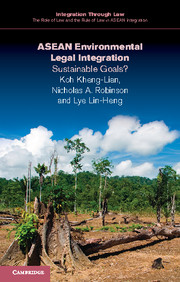Book contents
- Frontmatter
- Contents
- List of tables
- General editors’ preface
- Foreword – Professor Tommy
- Acknowledgments
- Introduction: exploring environmental law in Southeast Asia
- 1 ASEAN and environmental sustainability
- 2 Integrating sustainability into ASEAN state practice
- 3 The environment in the ASEAN region
- 4 Environmental sustainability laws in the ASEAN member states
- 5 ASEAN collaboration towards environmental sustainability
- 6 ASEAN and climate disruption
- 7 Conclusions: ASEAN's challenging way forward
- Executive summary
- Appendix A ASEAN organizational structure relevant to the environment – the ASEAN Charter
- Appendix B Founding of ASEAN – a short history
- Index
3 - The environment in the ASEAN region
Published online by Cambridge University Press: 05 April 2016
- Frontmatter
- Contents
- List of tables
- General editors’ preface
- Foreword – Professor Tommy
- Acknowledgments
- Introduction: exploring environmental law in Southeast Asia
- 1 ASEAN and environmental sustainability
- 2 Integrating sustainability into ASEAN state practice
- 3 The environment in the ASEAN region
- 4 Environmental sustainability laws in the ASEAN member states
- 5 ASEAN collaboration towards environmental sustainability
- 6 ASEAN and climate disruption
- 7 Conclusions: ASEAN's challenging way forward
- Executive summary
- Appendix A ASEAN organizational structure relevant to the environment – the ASEAN Charter
- Appendix B Founding of ASEAN – a short history
- Index
Summary
Evergreen tropical forests, mountain forests, monsoon forests, limestone and karst formations, wetlands, marine and coastal waters – these are among the major habitats or ecosystems found in Southeast Asia that store the world's largest collection of plant and animal life. These are life-giving resources for over half a billion people of the region and millions more around the world.
Dr. Surin Pitsuwan, ASEAN Secretary-General3.1 Evaluating bio-geographic trends in the ASEAN region
Members of ASEAN share a common appreciation of nature in their customs, religious beliefs and social values. They also share the experiences of rapid urbanization and growing national populations. From 450 million in 1990, more than 622 million people live in ASEAN's ten countries in 2012, soon to be an estimated 650 million by 2020. Human population growth is most rapid in Indonesia (40 percent), the Philippines (17 percent) and Vietnam (16 percent), and the demands on environmental resources grow commensurately. All people among member states rely on the environment for their livelihoods, whether directly or indirectly. Despite disparities in levels of socio-economic development, with gross domestic product per person ranging from US$59,937 to US$1,327, member states collaborate to identify what is needed for environmental protection and the attainment of sustainable development. They cooperate through five-year planning cycles to build their capacity to provide environmental protection as a pillar for socio-economic development. Member states have made significant gains in building their capacity to be stewards of nature and natural resources, and to implement regionally their national obligations under multilateral environmental agreements and other environmental treaties. Nonetheless, as ASEAN's Secretary-General acknowledges:
The environmental performance of most ASEAN Member States, as assessed by reputable studies, is above the world average, and the ecological footprint is much lower than that of many nations. However, ASEAN will continue to face growing environmental challenges given the need to lift a third of its population earning less than $2 a day out of poverty, and the many other pressures exerted on the environment such as population growth, urbanization and industrialization.
Law provides both a significant foundation and an effective procedure for ASEAN member states as they pursue intergovernmental environmental cooperation. The ASEAN Way encourages the sharing of goals and agreement by consensus on a phased pacing of capacity building for environmental stewardship, as discussed in Chapter 5 of this study.
- Type
- Chapter
- Information
- ASEAN Environmental Legal IntegrationSustainable Goals?, pp. 37 - 81Publisher: Cambridge University PressPrint publication year: 2016



